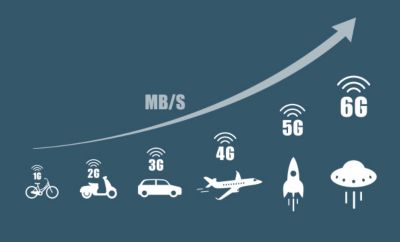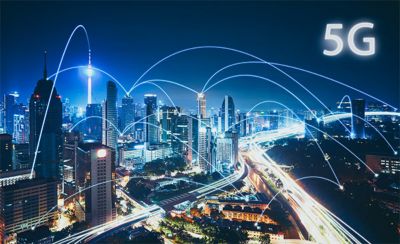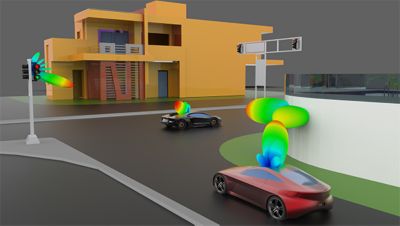ANSYS BLOG
November 13, 2019
Understanding 5G Infrastructure Benefits & Challenges
Newsrooms and techno analysts around the world are consistently talking about 5G. It’s the fifth-generation cellphone radio frequency (RF) communications network.
This new communication standard will have tremendous impact on society thanks to its low latency (in the order of a milliseconds) and speed (over 10 gigabits per second).
To the average consumer, this means you will be able to quickly download, watch and send high-definition 4K videos. In fact, a stadium, packed with people, could simultaneously post videos of a miracle touchdown.
For industry, 5G networks will have numerous applications, most notably in the automotive sector.
How Will Future RF Communications Differ?
Current 4G networks use antennae that generate transmissions over a broad area. In this setup, the signal delay is inversely proportional to the distance between the transmitter and receiver.
5G transmitters will use millimeter wave and multiple-input, multiple-output (MIMO) techniques to send directional RF communications with low latency, high data rates and enhanced channel capacity.
RF communications will become much faster.
The benefit is that instead of transmitting the wave’s energy around a sphere, MIMO antennas send the energy in a specific direction. This directionality enables targeted coverage that concentrates on individual equipment or small geographical areas.
5G Infrastructure & Networks Will Implement the Technology of the Future
Ericsson predicts that the 5G network will grow into a $1.2 trillion dollar industry.
One of the most obvious industries to benefit from this trend will be the automotive sector. The increased bandwidth and speed will help engineers create advanced infotainment systems and improve the safety of autonomous vehicles.
A passenger plays with an autonomous vehicle’s infotainment system.
Similar to the stadium video sharing example, infotainment systems on busy streets will need high bandwidth to ensure each passenger is satisfied with their multimedia streaming.
As for autonomous vehicles, they will be consistently collecting data from sensors, cameras, sonar, lidar and radar. In fact, Intel ran the numbers and estimated that an autonomous car could generate 4 TB of data each day. The boosts in communication speed and bandwidth will make it possible for the data to be transferred, processed and returned to the car fast enough for it to respond to the world around it.
Another safety benefit to the automotive sector is that these new transmission speeds will ensure fast vehicle-to-vehicle communications between self-driving cars.
5G infrastructure will affect many more industries thanks to the development of the Internet of Things (IoT). To learn more, watch the Internet of Things Webinar Series.
The Challenges to Implement 5G Infrastructure
5G networks are being tested in various cities around the world. These tests have shed light on a few challenges surrounding their implementation.
One of the biggest challenges is proximity between antennae. People envision 3G and 4G cellphone towers that are a few dozen miles apart. The tradeoff for the speed and bandwidth boosts of the next generation of 5G antenna infrastructure is that they need to be a few hundred feet apart.
One of the challenges of implementing 5G infrastructure is the proximity of antennae.
This means that a major city could need an antenna at every major intersection, or closer, to get the network operational. To avoid “not in my backyard” (NIMBY) sentimentality and the costs of installing antennae every few blocks, engineers will need to design 5G infrastructure that is low cost, able to blend with existing infrastructure and capable of operating at frequencies suitable for a city.
Another important, yet challenging, 5G network infrastructure upgrade will be the need to replace fiber optic connections. Wireless speeds will only be as fast as the wired connection it communicates with. Therefore, slower connections will need to be replaced.
Going back to that stadium example, if it’s been built in the last few years then it likely has the fiber optics needed to handle the high bandwidth. However, if the stadium is older, then the connections will need to be replaced to handle the RF communication demands of the spectators.
How Simulation Will Help Engineers Address 5G Infrastructure Challenges
Implementing modern networks will be a huge undertaking. Building, testing and iterating these systems can be costly and time-consuming.
Simulation of 5G infrastructure
Fortunately, virtual prototyping and simulation can help reduce the development cycle and cost of testing these systems. Simulation also enables further innovations and redesigns of RF communication technology.
Wireless systems engineers can use simulation and system-level analysis to manage and improve the front-end designs of RF devices. It enables them to study and solve challenges associated with the device’s 3D physics and system integration. For instance, tools like:
- Ansys HFSS and Ansys HFSS SBR+ will improve the design and installed performance of antenna arrays
- Ansys Icepak will ensure the electronic assemblies and wireless equipment remain cool
- Ansys SIwave will improve the signal integrity, power integrity and reliability of printed circuit boards used in servers and large data centers
To learn about other simulation software that can help engineers design modern RF communication technologies, read: 5G Simulation Solutions. Or, discover how simulation speeds development at CES.




